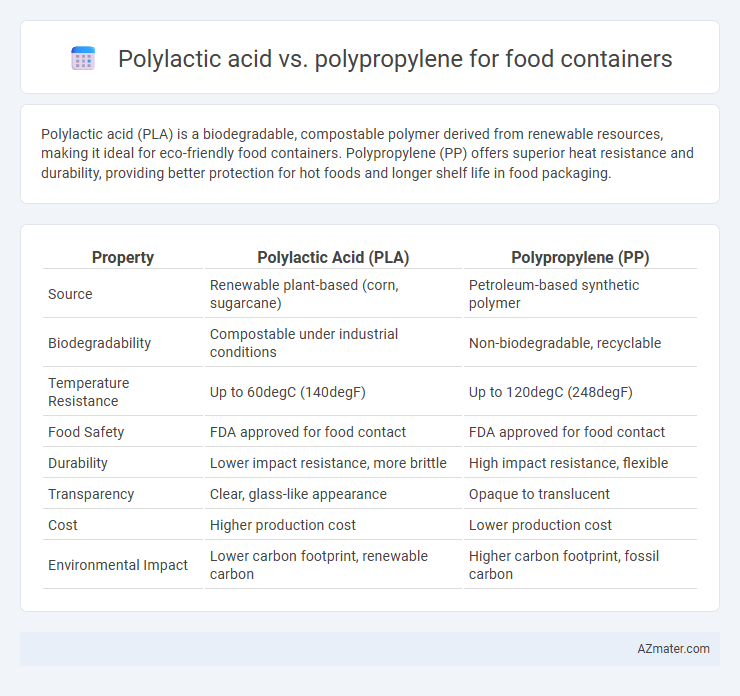Polylactic acid (PLA) is a biodegradable, compostable polymer derived from renewable resources, making it ideal for eco-friendly food containers. Polypropylene (PP) offers superior heat resistance and durability, providing better protection for hot foods and longer shelf life in food packaging.
Table of Comparison
| Property | Polylactic Acid (PLA) | Polypropylene (PP) |
|---|---|---|
| Source | Renewable plant-based (corn, sugarcane) | Petroleum-based synthetic polymer |
| Biodegradability | Compostable under industrial conditions | Non-biodegradable, recyclable |
| Temperature Resistance | Up to 60degC (140degF) | Up to 120degC (248degF) |
| Food Safety | FDA approved for food contact | FDA approved for food contact |
| Durability | Lower impact resistance, more brittle | High impact resistance, flexible |
| Transparency | Clear, glass-like appearance | Opaque to translucent |
| Cost | Higher production cost | Lower production cost |
| Environmental Impact | Lower carbon footprint, renewable carbon | Higher carbon footprint, fossil carbon |
Introduction to Polylactic Acid (PLA) and Polypropylene (PP)
Polylactic acid (PLA) is a biodegradable thermoplastic derived from renewable resources such as corn starch or sugarcane, widely used in eco-friendly food containers due to its compostability and low carbon footprint. Polypropylene (PP) is a petroleum-based polymer favored for its high durability, chemical resistance, and heat tolerance, making it a common choice for disposable and reusable food containers. Both materials offer distinct advantages in food packaging, with PLA emphasizing sustainability and PP focusing on performance and longevity.
Chemical Structure and Composition
Polylactic acid (PLA) is a biodegradable polyester derived from renewable resources like corn starch, composed of repeating lactic acid monomers with ester linkages. Polypropylene (PP) is a synthetic thermoplastic polymer made from propylene monomers, characterized by a hydrocarbon chain with methyl side groups. The ester bonds in PLA contribute to its biodegradability, while the hydrocarbon backbone of PP provides chemical resistance and durability, influencing their suitability for food container applications.
Manufacturing Process Comparison
Polylactic acid (PLA) is derived from renewable resources like corn starch through fermentation and polymerization, requiring lower processing temperatures around 180-200degC, which reduces energy consumption compared to polypropylene (PP). Polypropylene, a petroleum-based polymer, undergoes polymerization using propylene monomers with higher melting points of approximately 220-270degC, demanding more energy-intensive manufacturing involving injection molding and extrusion. PLA's biodegradability involves simpler chemical synthesis, while PP's manufacturing complexity supports superior mechanical properties but results in greater environmental impact during production.
Environmental Impact and Sustainability
Polylactic acid (PLA) for food containers offers significant environmental benefits due to its biodegradability and origin from renewable resources like corn starch or sugarcane, reducing reliance on fossil fuels. In contrast, polypropylene (PP), derived from petroleum, presents challenges in sustainability because it is non-biodegradable and contributes to plastic pollution. PLA's compostable nature supports circular economy practices, while polypropylene's durability and recyclability require well-managed recycling systems to mitigate long-term environmental impact.
Biodegradability and Compostability
Polylactic acid (PLA) offers superior biodegradability and compostability compared to polypropylene (PP), breaking down fully under industrial composting conditions within 1 to 6 months. Polypropylene, a petroleum-based polymer, is resistant to biodegradation, often persisting in the environment for decades, contributing to plastic pollution. PLA's renewable plant-based origins and certified compostable status make it a preferred choice for eco-friendly food containers focused on reducing environmental impact.
Food Safety and Regulatory Compliance
Polylactic acid (PLA) offers superior biodegradability and is certified as food-safe under FDA and EU regulations, making it a preferred choice for eco-friendly food containers. Polypropylene (PP) provides excellent chemical resistance and heat tolerance, maintaining food safety through compliance with FDA 21 CFR 177.1520 standards for repeated use and microwave applications. Both materials meet stringent regulatory requirements, but PLA's environmental benefits align with increasing consumer demand for sustainable food packaging solutions.
Thermal and Mechanical Properties
Polylactic acid (PLA) offers biodegradability with a lower melting point around 150-160degC, making it suitable for cold or room temperature food containers but less ideal for high-heat applications due to its lower thermal resistance. Polypropylene (PP) exhibits superior thermal stability with a melting point near 160-170degC and maintains mechanical strength at elevated temperatures, making it more suitable for microwaveable and dishwasher-safe food containers. Mechanically, PP has higher impact resistance and flexibility, whereas PLA tends to be more brittle but provides adequate rigidity for single-use packaging.
Cost Analysis and Market Availability
Polylactic acid (PLA) food containers typically have higher production costs than polypropylene (PP) due to expensive raw materials and lower economies of scale, impacting overall price competitiveness. Polypropylene is widely available in the market with established supply chains, offering cost-effective options suitable for mass production and food-grade applications. Despite higher initial costs, PLA's biodegradability is driving niche market demand, but PP remains dominant in food packaging due to affordability and extensive market presence.
Performance in Food Storage and Preservation
Polylactic acid (PLA) offers excellent biodegradability and maintains food freshness by providing good barrier properties against moisture and oxygen, making it suitable for short-term food storage. Polypropylene (PP) outperforms PLA in heat resistance and durability, allowing for safe reuse and microwaving without deformation or chemical leaching. For long-term food preservation, PP's superior chemical stability and resistance to oil and fat absorption ensure better protection against contamination and extended shelf life.
Future Trends and Innovations in Food Packaging
Polylactic acid (PLA) is gaining traction in food packaging due to its biodegradability and renewable sources, aligning with growing consumer demand for sustainable materials. Innovations such as enhanced PLA blends and improved barrier properties are expanding its usability for perishable food containers traditionally dominated by polypropylene (PP). Future trends highlight increased use of PLA combined with nanotechnology for antimicrobial packaging, positioning it as a viable eco-friendly alternative to polypropylene in the evolving food container market.

Infographic: Polylactic acid vs Polypropylene for Food container
 azmater.com
azmater.com